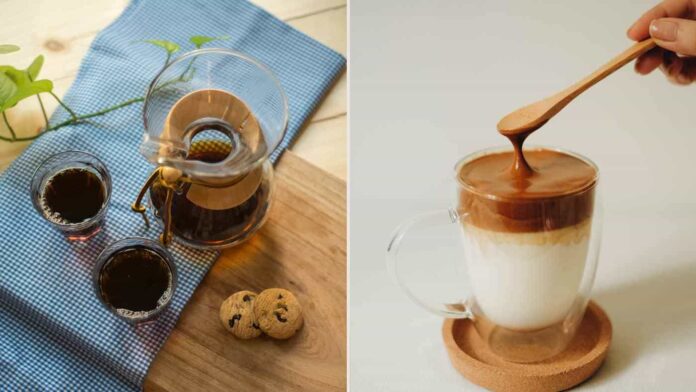Last Updated on June 24, 2024 by Sultana Parvin
Brewing the perfect cup of coffee at home is both an art and a science, a ritual that combines precision, passion, and personal preference.
This guide will help you in every aspect of coffee making, from selecting the finest beans and understanding the importance of grind size to mastering various brewing methods and recognizing the significance of water quality.
By the end of this guide, you’ll be equipped with the skills to craft a cup of coffee that not only meets but exceeds your expectations, but is almost the same as a coffee shop or better.
Table of Contents
How to Brew the Perfect Cup of Coffee at Home?
Brewing the perfect cup of coffee at home can be a rewarding experience that transforms your daily routine.
Here’s how you can brew your own perfect cup of coffee at home:
1. Choosing Your Coffee Beans:
There are two types of coffee beans, Arabica and Robusta.
Arabica is known for its smooth, mild flavor and aromatic qualities. Robusta is a stronger, more bitter flavor with higher caffeine content.
For freshness buy whole beans and grind just before brewing for maximum freshness. Check roast date and aim for beans roasted within the last 2-4 weeks.
2. Storing Your Coffee Beans:
Store your coffee beans in an airtight container and use opaque, airtight containers to keep beans fresh.
Store beans in a cool, dark place away from heat, moisture, and direct sunlight.
3. Grinding Your Coffee:
Grind Size
- Coarse is Ideal for French press and cold brew.
- Medium is suitable for drip coffee makers and pour-over.
- Fine is best for espresso machines and Aeropress.
Grinder Types
- Blade grinder is inexpensive but inconsistent grind.
- Burr grinder provides uniform grind size, essential for consistent flavor.
4. Measuring Coffee and Water:
Standard ratio for coffee-to-water Is 1:15 to 1:18 (1 gram of coffee per 15-18 grams of water). For stronger coffee, use a 1:15 ratio and for a milder coffee, use a 1:18 ratio.
Tools
Digital scale: For precise measurement use digital scale.
Scoop: Standard coffee scoop equals about 2 tablespoons.
5. Water Quality and Temperature:
Water Quality: Avoid using distilled or heavily mineralized water, use filtered water.
Ideal pH: The pH should be slightly acidic and around 7.0.
Temperature
- For optimal range 195°F to 205°F (90°C to 96°C).
- Too hot can scald the coffee, making it bitter.
- Too cold can result in under-extracted, weak coffee.
6. Brewing Methods:
Drip Coffee Maker
For a Drip Coffee Maker use a medium grind, and follow the manufacturer’s instructions for brewing, typically 4-5 minutes.
French Press
For a French Press use a coarse grind, and for brewing steep coffee for 4 minutes, then press.
Pour-Over
For Pour-Over use a medium grind, and for brewing pour water in a circular motion, maintaining a steady flow.
Aeropress
For an Aeropress use a fine grind, and for brewing steep for about 1 minute, then press.
Espresso Machine
For an Espresso Machine use a fine grind, and for brewing extract for 25-30 seconds.
7. Enhancing Your Coffee Experience:
For lattes and cappuccinos, steam milk to 150°F (65°C) and use a frother for foam.
For flavors use cinnamon, nutmeg, or cocoa powder and for syrups use vanilla, caramel, or hazelnut.
Brewing Tips
Use pre-wet filters for drip and pour-over methods, to remove papery taste, use warm up for french press, cups, and carafes to maintain optimal temperature.
Conclusion
Brewing the perfect cup of coffee at home involves a combination of quality ingredients, precise measurements, and the right techniques.
Experiment with different beans, grind sizes, and brewing methods to find your ideal cup. Enjoy the process and enjoy each sip!
